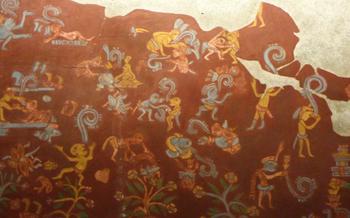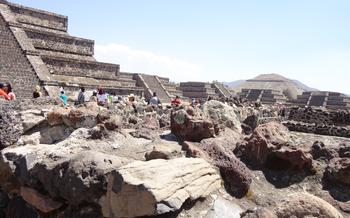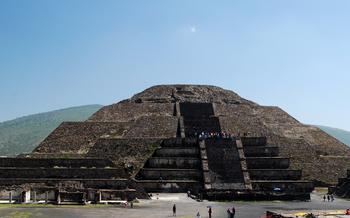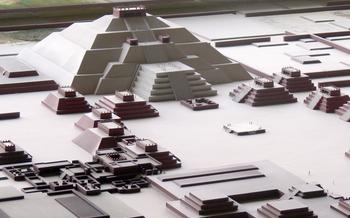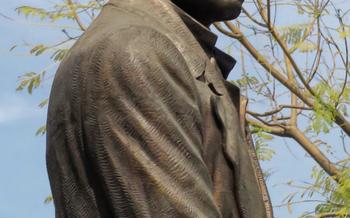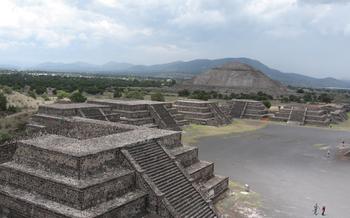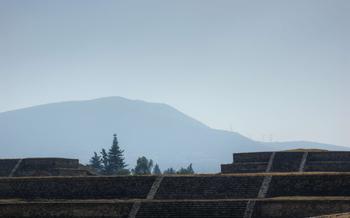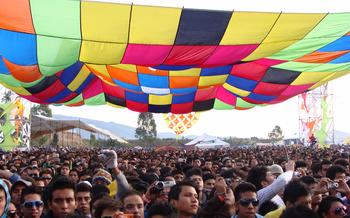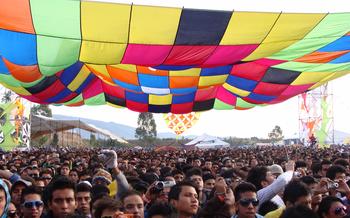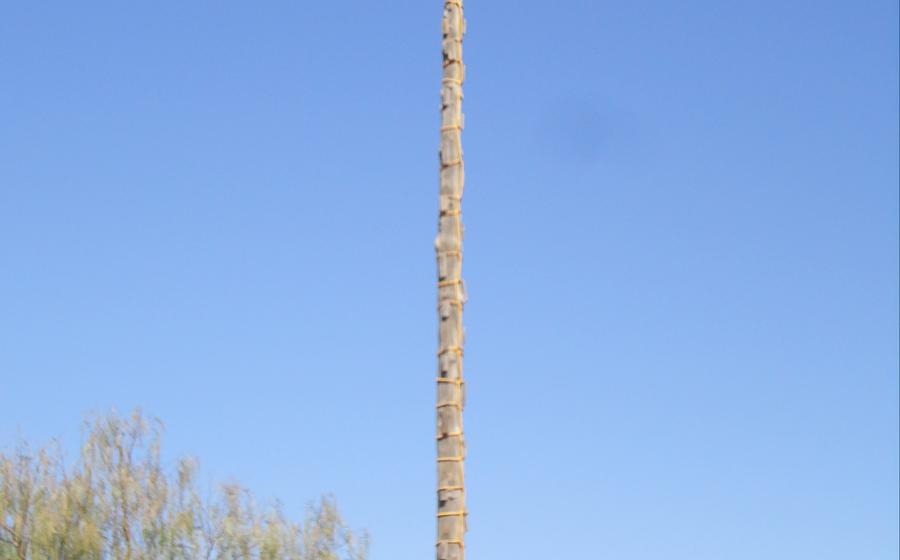
Universidad Nacional Autónoma de México (UNAM)
- A Journey to the Pantheon of the Gods: Unraveling Teotihuacan's Enigmatic Past
- The Avenue of the Dead: A Path Through Time
- Ascending the Pyramid of the Sun: A Physical and Spiritual Endeavor
- The Imposing Presence of the Pyramid of the Sun
- The Challenging Climb to the Summit
- Breathtaking Panoramic Views from the Top
- The Spiritual Significance of the Pyramid
- The Temple of Quetzalcoatl: A Masterpiece of Ancient Art
- The Museum of Teotihuacan: A Treasure Trove of Ancient Artifacts
- Exploring the Tunnels of Teotihuacan: A Journey into the Underworld
- Vibrant Teotihuacan: A City Alive with Tradition
- The Magic of Hot Air Ballooning: A Unique Perspective on Teotihuacan
- Universidad Nacional Autónoma de México (UNAM): A Legacy of Scholarship and Innovation
- Biblioteca Nacional de México: A Haven for Bookworms and Scholars
- Engaging with UNAM's Vibrant Student Life
- Insider Tip: The Best Time to Visit UNAM
A Journey to the Pantheon of the Gods: Unraveling Teotihuacan's Enigmatic Past
Teotihuacan, a majestic ancient city located just 45 kilometers northeast of Mexico City, stands as a testament to the ingenuity and grandeur of Mesoamerican civilizations. Its name, derived from the Nahuatl word "Teōtīhuacān," translates to "the place where men become gods," hinting at its profound spiritual significance.
Emerging as a prominent city-state around 100 BC, Teotihuacan reached its zenith between 100 and 750 AD, becoming one of the largest and most influential metropolises in the pre-Columbian Americas. Its sprawling urban complex, covering an area of over 20 square kilometers, housed an estimated population of 100,000 to 200,000 people.
The city's awe-inspiring architecture, characterized by towering pyramids, grand plazas, and intricate murals, showcased the advanced engineering and artistic prowess of the Teotihuacanos. The Avenue of the Dead, the city's central thoroughfare, stretched for over 2 kilometers, connecting the Pyramid of the Sun, the Pyramid of the Moon, and other significant structures.
Despite its grandeur, Teotihuacan's demise remains shrouded in mystery. Around 750 AD, the city was mysteriously abandoned, leaving behind a legacy of unanswered questions. Theories abound regarding its downfall, ranging from environmental factors like drought or volcanic eruptions to internal conflicts or invasions.
Teotihuacan's enduring legacy extends far beyond its physical remains. Its cultural and religious influence permeated Mesoamerica, shaping the development of subsequent civilizations such as the Aztecs and Mayans. The city's iconography, featuring feathered serpents, rain gods, and sacrificial rituals, continues to captivate and inspire contemporary artists and scholars alike.
The Avenue of the Dead: A Path Through Time
Stretching for over two miles, the Avenue of the Dead is the central axis of Teotihuacan, connecting the city's major landmarks and serving as a ceremonial and processional route. This grand thoroughfare was designed with astronomical precision, aligning with the solstices and equinoxes, demonstrating the advanced knowledge of the Teotihuacanos in astronomy and urban planning.
Along the Avenue of the Dead, visitors can admire an array of impressive structures, each with its own unique significance. The Pyramid of the Sun, the largest building in Teotihuacan, dominates the northern end of the avenue, while the Pyramid of the Moon, the second-largest pyramid, stands at the southern end. These colossal structures, with their imposing presence and intricate details, are a testament to the architectural prowess of the Teotihuacan civilization.
Other notable landmarks along the avenue include the Temple of Quetzalcoatl, with its iconic feathered serpent sculptures, and the Ciudadela, a large complex that once served as a religious and administrative center. Each of these structures tells a story about the beliefs, rituals, and daily life of the Teotihuacanos, offering a glimpse into the vibrant and sophisticated civilization that once flourished here.
Strolling down the Avenue of the Dead is a journey through time, allowing visitors to immerse themselves in the history and culture of ancient Teotihuacan. The avenue's grand scale, intricate architecture, and profound spiritual significance make it one of the most awe-inspiring and unforgettable experiences in Mexico.
Ascending the Pyramid of the Sun: A Physical and Spiritual Endeavor
In the heart of Teotihuacan, the Pyramid of the Sun stands as a testament to the ingenuity and spirituality of its ancient builders. Towering over the Avenue of the Dead, this colossal structure beckons visitors to embark on a challenging yet rewarding journey.
The Imposing Presence of the Pyramid of the Sun
The Pyramid of the Sun is a sight to behold, its massive form rising majestically from the surrounding landscape. As you approach, its sheer size and grandeur fill you with awe. Constructed using millions of adobe bricks, the pyramid's steep sides and imposing height create a sense of both wonder and trepidation.
The Challenging Climb to the Summit
Ascending the Pyramid of the Sun is no easy feat. The climb requires physical endurance and a steady pace, as the steps are steep and uneven. The altitude and the heat can also be challenging, especially during the midday sun. However, the reward for your efforts is immeasurable.
Breathtaking Panoramic Views from the Top
As you reach the summit of the Pyramid of the Sun, you are greeted by a breathtaking panorama that extends for miles in every direction. The ancient city of Teotihuacan unfolds before you, with its temples, palaces, and plazas laid out in a grid-like pattern. The surrounding mountains and valleys complete the stunning vista, creating a sense of timelessness and tranquility.
The Spiritual Significance of the Pyramid
Beyond its architectural magnificence, the Pyramid of the Sun holds deep spiritual significance for the ancient Teotihuacanos. It was believed to be the earthly representation of the sacred mountain Cerro Gordo, where the gods descended to interact with humans. The pyramid's alignment with the sun during the spring and fall equinoxes further emphasizes its connection to celestial events and the cyclical nature of life.
Ascending the Pyramid of the Sun is not just a physical challenge but also a spiritual journey. It is an opportunity to connect with the ancient civilization that built this awe-inspiring structure and to experience the profound sense of wonder and reverence that they felt for their gods and the cosmos.
The Temple of Quetzalcoatl: A Masterpiece of Ancient Art
Amidst the sprawling ruins of Teotihuacan, the Temple of Quetzalcoatl stands as a testament to the artistic prowess and religious beliefs of the ancient city's inhabitants. This unique structure, dedicated to the revered deity Quetzalcoatl, is a masterpiece of ancient architecture and a symbol of the city's cultural and spiritual heritage.
The temple's distinctive design sets it apart from other structures in Teotihuacan. While most buildings in the city feature simple, geometric forms, the Temple of Quetzalcoatl boasts a complex and elaborate facade adorned with intricate carvings. These intricate carvings depict a variety of mythological creatures, including serpents, jaguars, and the feathered serpent Quetzalcoatl himself.
The symbolic meaning of these carvings is a subject of ongoing debate among scholars. Some believe that they represent the deity's earthly and celestial domains, while others suggest that they tell a story about the creation of the world or the journey of the soul after death. Regardless of their exact meaning, these carvings offer a glimpse into the complex and fascinating religious beliefs of the Teotihuacanos.
The figure of Quetzalcoatl himself holds a central place in Teotihuacan mythology. Often depicted as a feathered serpent, Quetzalcoatl was associated with wind, rain, and fertility. He was also considered a patron of learning and knowledge, and his temple was likely a place where priests and scholars gathered to study and perform religious rituals.
By exploring the Temple of Quetzalcoatl, visitors can gain a deeper understanding of the religious beliefs and artistic traditions of the ancient Teotihuacanos. This magnificent structure stands as a testament to their creativity, ingenuity, and devotion to their gods.
The Museum of Teotihuacan: A Treasure Trove of Ancient Artifacts
Within the sprawling archaeological complex of Teotihuacan lies a treasure trove of ancient artifacts, carefully preserved and showcased at the Museum of Teotihuacan. This world-renowned institution houses an extensive collection of sculptures, pottery, murals, and other objects that provide invaluable insights into the daily life, culture, and beliefs of the Teotihuacanos, one of Mesoamerica's most advanced civilizations.
The museum's collection is a testament to the artistic prowess and sophisticated craftsmanship of the Teotihuacanos. Elaborate stone carvings, intricate ceramic vessels, and vibrant murals adorn the museum's galleries, offering a glimpse into the rich artistic traditions of this ancient civilization. These artifacts showcase the Teotihuacanos' mastery of various techniques, from stone carving and pottery to painting and weaving.
Beyond its artistic significance, the Museum of Teotihuacan plays a crucial role in preserving and interpreting the archaeological discoveries made at the site. Through its extensive collection and ongoing research, the museum contributes to our understanding of Teotihuacan's history, urban planning, religious practices, and trade networks. It serves as a valuable resource for scholars, researchers, and visitors seeking to delve deeper into the mysteries of this ancient metropolis.
The museum's archaeological discoveries have shed light on various aspects of Teotihuacan's culture and society. Excavations have revealed evidence of a complex political and social structure, a sophisticated system of writing, and a diverse religious pantheon. The museum's collection includes artifacts related to these discoveries, such as stone sculptures depicting rulers and deities, ceramic vessels used in rituals, and codices containing hieroglyphic inscriptions.
By preserving and interpreting Teotihuacan's rich legacy, the Museum of Teotihuacan plays a vital role in safeguarding Mexico's cultural heritage and promoting a deeper appreciation for this ancient civilization. It stands as a testament to the enduring power of human creativity and the importance of preserving our shared past for generations to come.
Exploring the Tunnels of Teotihuacan: A Journey into the Underworld
Beneath the sprawling ancient city of Teotihuacan lies a hidden labyrinth of tunnels, inviting intrepid explorers on an extraordinary journey into the underworld. These subterranean passages, shrouded in mystery and intrigue, offer a unique perspective on the city's enigmatic past and provide a glimpse into the beliefs and rituals of the Teotihuacanos.
The tunnels, discovered in the early 20th century, were meticulously carved out of the bedrock by the city's inhabitants, their purpose still a matter of debate among scholars. Some believe they served as a drainage system, while others propose they were used for religious ceremonies or even as a secret escape route in times of danger.
Venturing into the tunnels is an experience that combines adventure, history, and a touch of the unknown. Visitors can embark on guided tours, led by knowledgeable experts who provide insights into the construction, purpose, and significance of these underground chambers.
The tunnels are generally safe and accessible, though visitors should be prepared for a physically demanding experience. The passages are often narrow and require crouching or crawling in some sections. Helmets and flashlights are provided to ensure safety and visibility in the dimly lit environment.
As you navigate the tunnels, the sense of awe and wonder grows with each step. The walls are adorned with intricate carvings and symbols, hinting at the rich mythology and beliefs of the Teotihuacanos. The air is cool and humid, adding to the mystical atmosphere.
Emerging from the tunnels, you will have gained a deeper appreciation for the ingenuity and craftsmanship of the ancient Teotihuacanos. The experience will leave you with a lasting memory of your journey into the underworld, where the secrets of a lost civilization await discovery.
Vibrant Teotihuacan: A City Alive with Tradition
Beyond the ancient ruins, Teotihuacan is a city pulsating with life, steeped in tradition, and infused with the warmth of the local community. A vibrant tapestry of culture unfolds in the bustling local markets, where vendors proudly display their handmade crafts, from intricate pottery to colorful textiles. The air is alive with the tantalizing aromas of authentic Mexican cuisine wafting from local eateries, inviting visitors to indulge in culinary delights that have been passed down through generations. The people of Teotihuacan exude a genuine warmth and hospitality, welcoming visitors with open arms and sharing their rich cultural heritage with pride.
The Magic of Hot Air Ballooning: A Unique Perspective on Teotihuacan
Soar above the ancient city of Teotihuacan in a hot air balloon and witness its grandeur from a truly unique perspective. Float effortlessly over the sprawling pyramids, temples, and plazas, marveling at the scale and precision of this ancient metropolis.
As the sun rises, casting a golden glow over the landscape, watch the shadows of the pyramids stretch across the valley. Take in the breathtaking panorama of the surrounding mountains and the vast expanse of the Basin of Mexico. Experience the thrill of floating above the clouds, with nothing but the gentle breeze and the sound of the burner keeping you company.
Capture breathtaking photographs of the iconic landmarks from above, creating lasting memories of your journey to Teotihuacan. Whether you're a seasoned hot air balloon enthusiast or a first-timer, this once-in-a-lifetime experience will leave you with an unforgettable impression of this ancient city and its enduring legacy.
Universidad Nacional Autónoma de México (UNAM): A Legacy of Scholarship and Innovation
The Universidad Nacional Autónoma de México (UNAM), founded in 1551, stands as a beacon of academic excellence and innovation in Mexico. With a rich history spanning over four centuries, UNAM has played a pivotal role in shaping the intellectual and cultural landscape of the nation. Its stunning campus in Mexico City, a UNESCO World Heritage Site, is a testament to the university's enduring legacy and commitment to higher education.
UNAM boasts a diverse range of academic programs, fostering a vibrant intellectual community that attracts students from across Mexico and beyond. Renowned for its research achievements, the university has made significant contributions to various fields, including science, engineering, medicine, and the humanities. Its research centers and institutes are at the forefront of cutting-edge research, pushing the boundaries of knowledge and driving innovation.
Beyond its academic pursuits, UNAM is deeply engaged in cultural and artistic endeavors. The university's cultural centers and museums host exhibitions, concerts, and performances, showcasing the works of renowned artists and promoting cultural exchange. UNAM also plays a crucial role in preserving and disseminating Mexico's rich cultural heritage through its extensive library and archival collections.
As a leading educational institution, UNAM is committed to social responsibility and outreach. It actively engages with the surrounding community through various initiatives, such as community service programs, public lectures, and educational workshops. UNAM's commitment to social justice and equality is reflected in its efforts to promote access to higher education for students from marginalized backgrounds.
With its unwavering dedication to academic excellence, groundbreaking research, and cultural enrichment, UNAM stands as a beacon of higher learning in Mexico and a source of pride for the nation. Its legacy of scholarship and innovation continues to inspire generations of students and scholars, shaping the future of Mexico and contributing to the global advancement of knowledge.
Biblioteca Nacional de México: A Haven for Bookworms and Scholars
Nestled within the heart of Mexico City, the Biblioteca Nacional de México stands as a testament to the country's rich literary and scholarly heritage. With a collection that spans over two million volumes, including rare and valuable manuscripts, this library is a treasure trove for bookworms, researchers, and anyone seeking knowledge.
Founded in 1833, the National Library of Mexico has played a pivotal role in promoting literacy, scholarship, and cultural preservation in the country. Its vast collection encompasses a diverse range of subjects, from history and literature to science and philosophy. The library is particularly renowned for its extensive collection of Mexican and Latin American literature, offering a comprehensive insight into the region's literary traditions.
The library's architectural beauty is equally impressive. Housed in a stunning neoclassical building, the library features elegant interiors, grand staircases, and ornate reading rooms. The tranquil ambiance and comfortable seating arrangements create an ideal environment for study and contemplation. The library is also home to a number of murals and sculptures, adding to its artistic charm.
The National Library of Mexico is not just a repository of knowledge but also a vibrant center for cultural activities. Throughout the year, the library hosts exhibitions, conferences, book launches, and literary events, providing a platform for intellectual exchange and engagement. These events attract scholars, writers, and members of the public, fostering a sense of community and encouraging a lifelong love of learning.
Engaging with UNAM's Vibrant Student Life
UNAM is not just a center of academic excellence but also a hub of vibrant student life. The diverse and dynamic student community creates an energetic and engaging atmosphere on campus. As a visitor, you have the opportunity to immerse yourself in this vibrant culture and interact with students from all over the world.
One way to experience the student life at UNAM is to attend student events and activities. Throughout the year, the university organizes various cultural, social, and sporting events that are open to the public. These events provide an excellent opportunity to meet students, learn about Mexican culture, and make new friends.
Another way to engage with the student community is to join student clubs or organizations. UNAM has over 1,000 student organizations covering a wide range of interests, from sports and music to politics and social activism. By joining a club, you can connect with students who share your passions and get involved in extracurricular activities.
The student life at UNAM is a microcosm of Mexican society, reflecting the country's rich cultural diversity and youthful energy. By engaging with the student community, you will gain a deeper understanding of Mexican culture and make memories that will last a lifetime.
Insider Tip: The Best Time to Visit UNAM
To fully appreciate the splendor of UNAM and avoid the sweltering summer heat, plan your visit during the shoulder months, from March to May or September to November. During this period, the weather is pleasant, with average temperatures ranging from 20 to 25 degrees Celsius. Crowds are also thinner, allowing you to explore the campus and its attractions at a more leisurely pace.
For an unforgettable experience, visit UNAM during one of its many cultural events or festivals. The university hosts a variety of events throughout the year, including concerts, art exhibitions, and theater performances. Check the UNAM website or social media pages for upcoming events and plan your visit accordingly.
To make the most of your visit, arrive early to avoid long lines and give yourself ample time to explore the vast campus. Comfortable shoes are a must, as you'll be doing a lot of walking. Don't forget to bring a camera to capture the stunning architecture and vibrant atmosphere of UNAM.
